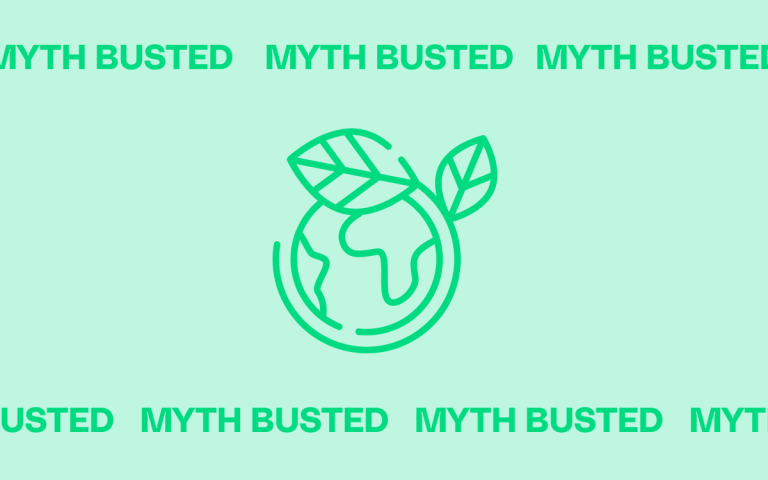
Responsibility
Old ideas, new packaging? – Myths of Green Web Services, Part 1
Pauliina Kiviranta, Senior Designer & GSW task force member
In the first part of our blog series examining misconceptions revolving around sustainability themes, we clarify what green digital services entail concretely and what is actually new about this.
Green web services and efforts towards the ecology of digital products raise numerous thoughts, questions, and occasionally criticisms. Some of these questions and criticisms are indeed valid, but among them, there are also many unnecessary misconceptions that create pitfalls on the path toward more sustainable digital services. We decided to delve into this topic and debunk these myths one by one in this blog series.
What on earth is a digital carbon footprint?
A digital carbon footprint is a concept used to assess greenhouse gas emissions arising from the production and use of digital services and products. To even contemplate how online content and other digital services can become greener, it’s necessary to shed some light on what constitutes a digital carbon footprint and how it can be measured.
It would be quite simple if there were a standardized tool for measuring carbon footprints (similar to us humans stepping on a scale to check our weight), but unfortunately, this is not the case. The available tools are always complex due to the nature of the task.
The internet is filled with various calculators, browser extensions, and tools designed for evaluating carbon footprints. However, the resulting figure always depends on the variables chosen by the tool’s creator, making the results not directly comparable or standardized. This characteristic doesn’t inherently make these tools bad or unreliable, but it’s essential to use them while acknowledging the challenges and to compare results only when measured using the same tool.
If this sounds suspicious, let’s delve a bit deeper into the matter.
Each digital carbon footprint calculator may employ slightly different principles compared to another, but the main objective is usually somewhat similar: to measure how many greenhouse gas emissions a digital product generates when in use. In its simplest form, these emissions consist of the electricity consumed when data transfers between the user’s device and the data center.
Electricity consumption can also be assessed from various perspectives, such as how much energy is used for data storage or how much the product’s usage depletes the user’s device battery. Besides measuring only electricity consumption, this data can be enriched with various features refining the equation, such as information on hosting the service with sustainable energy sources.
Although the methods of measurement are diverse, the primary goal for reducing the carbon footprint is simple – the less electricity a web service or application consumes and the less data it stores, the more energy-efficient the service becomes.
In other words, at a high level, the two most crucial methods for keeping the carbon footprint in check are lightweight design, implementation, and content production of the service, and avoiding unnecessary data – not just analytics data but any digitally stored information. In practice, this means optimizing code, excluding large and unnecessary media files, avoiding unnecessary embeds and scripts, and creating straightforward user paths. Data should only be collected, generated, and stored as needed, not mindlessly dumped into the cloud.
Myth #1 – Old tricks in a new package?
Readers might now be thinking: “Wait a minute, aren’t these methods described above nothing new? These have been utilized in software production since the early days of the internet! Websites and their content were optimized back in the 90s! Is someone trying to sell old tricks in a polished package and pretend that it’s some revolutionary innovation?”
Admittedly, this myth is both true and false at the same time. It is indeed true that many old proven optimization techniques are still effective – their fundamental purpose has always been the same, to reduce the consumption of the produced service and make them as lightweight as possible.
However, what’s often forgotten here is that a couple of decades ago, the constraints were dictated by technological scarcity. Web services had to be lightweight so that they opened on users’ devices, and data storage had to be minimized because storage capacity simply couldn’t be wasted.
Technological possibilities have skyrocketed in the past decade, and now we have cloud services, broadband connections, and highly efficient (by standards of ten years ago, at least) end devices at our disposal. In other words, technology is no longer the bottleneck.
Electrification and digitization are mega-trends that have been touted as responses to mitigating climate change. However, this isn’t necessarily automatic – when misused, these solutions can equally become part of the problem.
In the past few decades, we’ve struggled to move away from technological scarcity. However, on the other hand, we haven’t yet learned how to act responsibly with our achievements.
Although the digital revolution has made web services efficient for their users, and this efficiency feels entirely intangible, in terms of electricity consumption, it is not. Instead, global data traffic and data storage consume more and more energy with each passing year.
Digital abundance is now at our disposal, and the next step in development is to learn to use this abundance responsibly and sustainably.
The tools for this can be found in both old methods and new solutions. The goal of green web services is not to try to present old solutions as new innovations but rather to bring some of them value in the current operating environment.
Whether the methods chosen are old or new, it’s always worthwhile to improve the energy consumption and carbon footprint of your own digital service. Feel free to reach out to us if you’re interested in considering what approach would suit your service! You can read more about this on our Green Sustainable Web page.
Contact us
Send us a message, and let's get your digital carbon footprint in shape!
"*" indicates required fields


